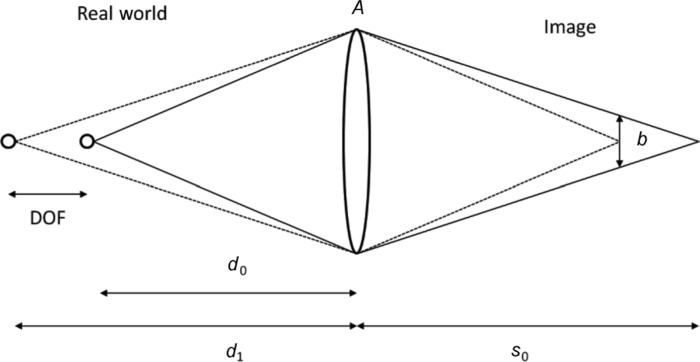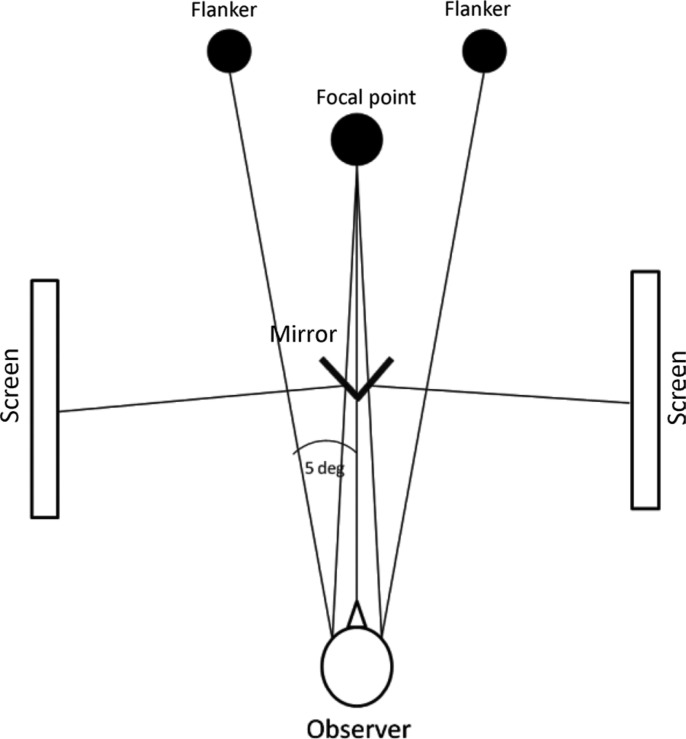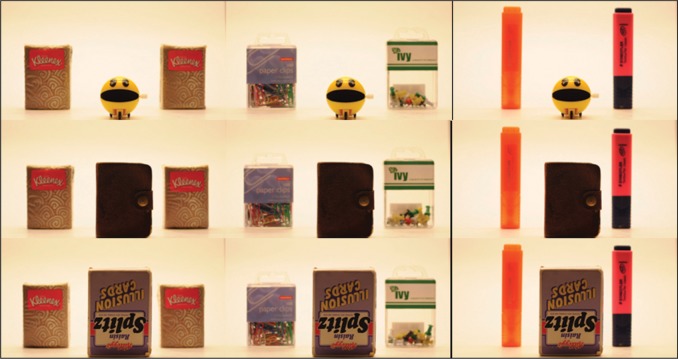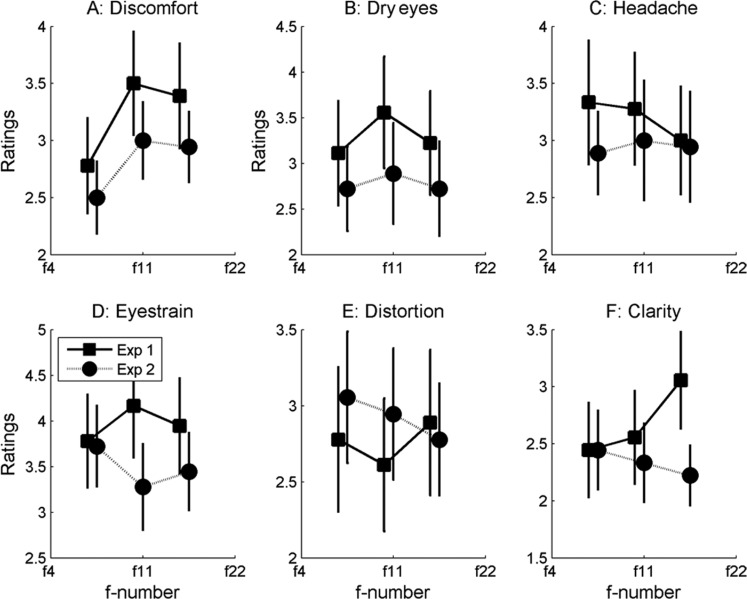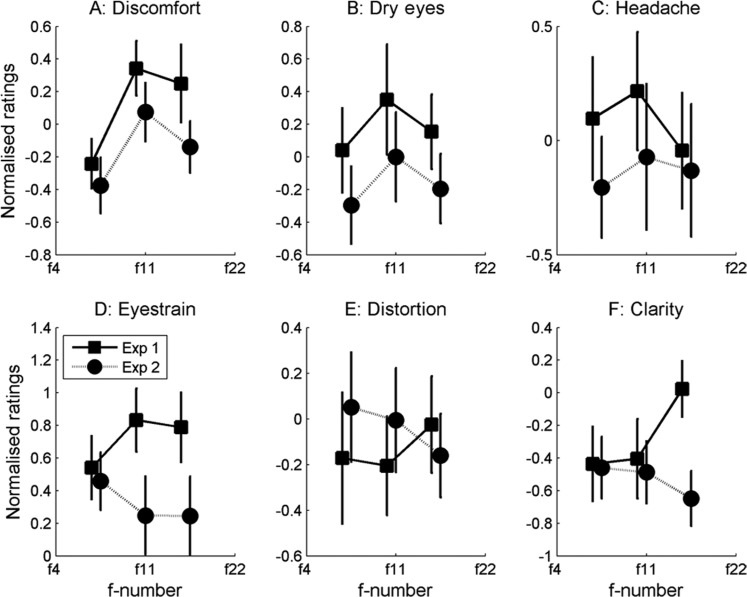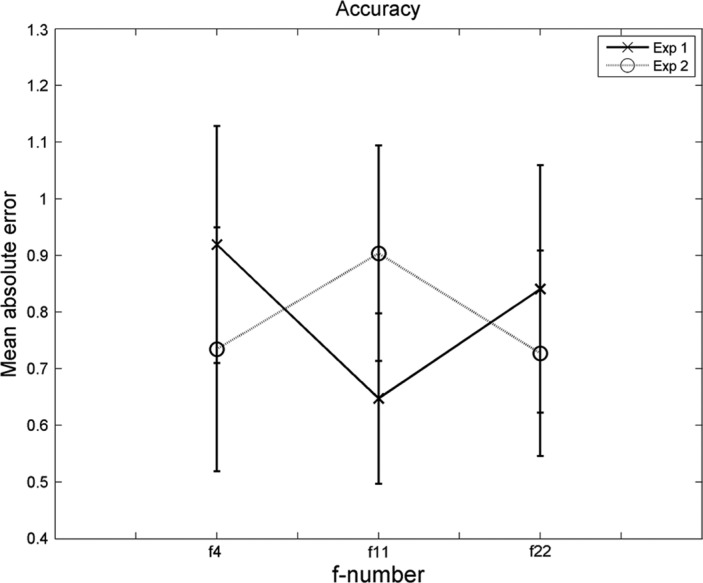Abstract
Visual discomfort has been reported for certain visual stimuli and under particular viewing conditions, such as stereoscopic viewing. In stereoscopic viewing, visual discomfort can be caused by a conflict between accommodation and convergence cues that may specify different distances in depth. Earlier research has shown that depth-of-field, which is the distance range in depth in the scene that is perceived to be sharp, influences both the perception of egocentric distance to the focal plane, and the distance range in depth between objects in the scene. Because depth-of-field may also be in conflict with convergence and the accommodative state of the eyes, we raised the question of whether depth-of-field affects discomfort when viewing stereoscopic photographs. The first experiment assessed whether discomfort increases when depth-of-field is in conflict with coherent accommodation–convergence cues to distance in depth. The second experiment assessed whether depth-of-field influences discomfort from a pre-existing accommodation–convergence conflict. Results showed no effect of depth-of-field on visual discomfort. These results suggest therefore that depth-of-field can be used as a cue to depth without inducing discomfort in the viewer, even when cue conflicts are large.
Keywords: depth-of-field, visual discomfort, natural images, blur
1. Introduction
1.1. Depth-of-field blur
Correctly focussed images can contain a certain amount of blur, determined by the optics of the camera and the spatial arrangement of the scene. Images usually contain projections of objects at different distances from the camera. The distance range of objects that are in acceptable focus in the resulting image is determined by the optics of the camera, and is called the image's “depth-of-field” (DOF). Strictly speaking, the DOF is the range of real-world depth within which all objects are in acceptable focus, as shown in Figure 1. The effects of DOF on the image will be referred to here as DOF blur.
Figure 1.
A simplified diagram of depth-of-field and the blurring effects caused by DOF-related optics. DOF is the depth-of-field, d0 is the distance to the focal point, d1 is the distance to the non-fixated object, s0 is the axial length, and b is the diameter of the blurred region of the resulting image (blur circle). A is the aperture.
All other things being equal, the smaller the DOF, the greater is the blur circle (more of the image is blurred). Blurring effects from DOF depend on both the distance from the observer to the focal point (termed here “egocentric distance” and the aperture size (see Equation (1), based on that given by Hoffman & Banks, 2010):
 |
(1) |
where b is the blur circle, the diameter of the part of the image determined to be blurred, A is the pupil diameter, s0 is the axial length, d0 “egocentric distance” is the distance from the observer to the focal point, and d1 “flanker distance” is the distance in depth from the observer to the blurred object (flanker). The diameter of the blur circle increases with increasing distance in depth from the point of focus.
As can be seen from Equation (1), DOF depends on the aperture size relative to the viewing distance. A shallow DOF occurs when the viewing distance is relatively small compared with the aperture diameter and thus typically occurs at close viewing distances or large aperture sizes (see Equation (1)). A shallow DOF creates a large amount of blur in the resulting image with just a small depth difference between the focal plane and the object. This is demonstrated in the left photograph of Figure 2, which was created using a large camera aperture, and therefore the resulting image has a shallow DOF, and a large amount of image blur. The right photograph of Figure 2 was taken using a small aperture, and therefore much of the image is in sharp focus.
Figure 2.

Depth-of-field effects. Left: shallow depth-of-field, with large blur gradients. Although the background of the photograph on the left is mostly blurred, the focal point is sharp. Right: large depth-of-field: much of the image is in focus, even the flanking objects, which are farther away than the focal point.
1.2. Depth-of-field as a cue to distance
As DOF depends on the viewing distance and aperture size, DOF blur could conceivably be used as a cue to egocentric distance (between the observer and the focal plane) as well as to the depth range (the range of depths of the objects present in the scene). Empirical data suggest that observers indeed use DOF blur in this way. Vishwanath and Blaser (2010) showed that DOF blur affects estimates of egocentric distance; increasing blur gradients caused observers to report smaller estimates of egocentric distance to the focal point. Held, Cooper, O'Brien, and Banks (2010) showed that perceived camera distance was significantly affected by introducing blur gradients to photographs that simulated DOF blur. Nefs (2012) showed that perceived depth is greater with a shallow DOF than with a deep DOF in non-stereo photographs. Blur gradients also affect the perception of a plane slanted in depth under monocular viewing conditions (Watt, Akeley, Ernst, & Banks, 2005). Currently, unpublished observations by Zhang, Nefs, and Heynderickx (in preparation) indicate that observers are able to reliably discriminate differences in DOF, and that this ability depends on the scale of the scene in both stereo and non-stereo photographs. Additionally, Held, Cooper, and Banks (2012) found that just-noticeable difference (JND) for perceived depth from disparity and DOF blur was dependent on egocentric distance—at closer egocentric distances, smaller JNDs were found with disparity cues, but at farther distances, DOF blur cues specifying depth resulted in smaller JNDs. This suggests that DOF blur might even represent a more useful cue to depth than disparity at these greater egocentric distances.
Earlier research has shown that DOF blur can not only be detected but may also influence performance when using stereoscopic displays. Banks, Akeley, Hoffman, and Girshick (2008) found performance at an orientation detection task improved when blur was appropriate for the convergence distance. Additionally, DOF blur can also reduce rivalry from monocular regions in stereoscopic images (Hoffman & Banks, 2010). Hillaire, Lecuyer, Cozot, & Casiez (2008) showed that adding blur gradients to simulate DOF blur cues facilitated computer-game playing for inexperienced players, and these players also judged the DOF blur gradients to add realism to the scenes. However, the performance of experienced players was not increased with the addition of these blur gradients. Some players judged the additional blur to increase fatigue and discomfort. Therefore, DOF blur can be judged as more aesthetically pleasing and facilitate performance, but can also hinder performance and induce visual discomfort.
1.3. Discomfort from stereoscopic displays
Stereoscopic viewing often involves conflicting accommodation–convergence cues that arise from presenting stimuli at non-zero disparities. This conflict can be a source of discomfort in stereoscopic images (e.g. Hoffman, Girshick, Akeley, & Banks, 2008; Shibata, Kim, Hoffman, & Banks, 2011a; Shibata, Kim, Hoffman, & Banks, 2011b; Wann, Rushton, & Mon-Williams, 1995). DOF blurring provides an additional source of egocentric distance information, which can conflict with that from other cues. This raises the possibility that DOF blur could also affect discomfort in stereoscopic displays. There are at least two ways in which this could occur. First, if the visual system has tacit knowledge of the appropriate DOF blur for the scene, given the instantaneous pupil size and the estimate of egocentric distance from accommodation and convergence, then inappropriate DOF blur gradients could cause visual discomfort through conflict with other cues. These situations can easily arise when viewing stereoscopic photographs if the camera aperture was larger than can possibly be achieved with a real human pupil.
Second, DOF blur gradients might influence the discomfort caused by pre-existing accommodation–convergence conflicts. For example, DOF blur specifying that the focal plane is at the screen distance provides additional evidence to support the accommodation response. If convergence specifies a different distance, this would increase the conflict between the combined-cue distance estimate and the convergence-based distance estimate. Alternatively, DOF blur could erode the disparity signal from the objects in the background, because precise estimation of disparity relies on high spatial frequency information (Smallman & MacLeod, 1997). Blurring the high spatial frequencies would then reduce the reliability of the disparity-defined convergence cue, such that it would provide less precise information about convergence. This weakening may in turn affect the magnitude of the accommodation–convergence conflict as well. Thus, DOF blur might reduce the effect of the accommodation–convergence conflict on discomfort.
1.4. Visual discomfort and blur
In addition to providing a potentially conflicting depth cue, blur itself can be a direct cause of discomfort. Manipulations that decrease the relative power at high spatial frequencies, compared with the power typically present in natural images, increase visual discomfort (Fernandez & Wilkins, 2008; Juricevic, Land, Wilkins, & Webster, 2010; O'Hare & Hibbard, 2011, O'Hare & Hibbard, 2013). Such manipulations tend to be perceived as a blurring of the image (Murray & Bex, 2010). These results might lead us to expect that DOF blur gradients also cause discomfort. However, an important distinction is that these studies have typically used global manipulations, which decrease the power at high spatial frequencies uniformly across the image, including the point of interest. This kind of global filtering is similar to the blurring that occurs when images are incorrectly focussed, which are blurred at all points in the image, including the point of interest. This situation is termed “defocussed” here. The accommodation response of the human eye uses high spatial frequency information to provide feedback for guiding responses (Charman, 1979; Charman & Tucker, 1977), so removing this information would impair accommodation control. Accommodation responses have been related to visual discomfort—prolonged reading tasks can increase discomfort judgements and also increase accommodative lag for some individuals (Tosha, Borsting, Ridder, & Chase, 2009). Globally blurred images could therefore be uncomfortable because they provide an insufficient signal for the control of accommodation.
By contrast, DOF blur gradients do not affect the accommodation response (Day, Siedel, Gray, & Strang, 2009): despite the majority of the image being blurred, the fixation point is in focus. It follows from this that, if DOF blur manipulations alone affect discomfort, then the cause must be blur per se, rather than its effect on accommodation responses. For this reason, DOF blur gradients are of theoretical interest for understanding why blur can sometimes cause discomfort.
Similar considerations apply when we consider why accommodation–convergence cue conflicts cause discomfort. This could be due to a motor conflict, arising from the cross-coupling between accommodation and convergence (Wann et al., 1995), or a sensory discrepancy between the conflicting estimates of distance from the two cues. If motor responses were responsible for discomfort, then DOF blur gradients would not be expected to directly contribute to this, as DOF blur does not affect the accommodation response. However, if sensory discrepancies are the cause of discomfort, then inappropriate DOF blur gradients might be expected to affect discomfort judgements, as these will specify a different depth from that specified by convergence and accommodation cues.
1.5. Current study
The first purpose of the current study was to investigate the role of DOF blur as a potential source of visual discomfort. The second purpose was to ascertain how DOF blur affects a known cause of visual discomfort, namely the conflict between accommodation and convergence. In Experiment 1, the distance to the focal plane was defined by consistent accommodation and convergence cues. The focal plane thus remained at zero disparity, that is, at the screen distance. The magnitude of DOF blur was manipulated by changing the camera aperture. DOF was either (1) appropriate for human optics (f11, appropriate levels of blur), (2) too deep (f22, too little blur), or (3) too shallow (f4, too much blur). We tested whether the appropriate level of DOF blurring for the assumed human optics would result in less discomfort than either too much or too little blur.
In Experiment 2, we assessed whether DOF blur acted on a pre-existing accommodation–convergence conflict. The accommodative distance remained constant at the screen distance. The convergence-defined distance however varied with the depth of the objects in the scene. This had the result that the disparity-defined focal point was projected to a closer distance than that specified by accommodation cues. In Experiment 2, the central object was always the one in sharp focus. However, it was no longer at zero disparity, thus creating a convergence–accommodation conflict.
2. Method
2.1. Apparatus
Scenes were photographed using a Nikon D90 digital camera with a fixed focal length lens of 50 mm. Photographs of the scenes were taken in a light box (Verivide Ltd., Leicester) to make the colour stereo half images. The direct illumination was from an overhead D65 840 lux daylight bulb. Stimuli were presented on a Wheatstone stereoscope consisting of two 17-inch NEC AccuSync LCD 72vm monitors, which were gamma corrected for colour using a Spyder pro 3 (Datacolor AG). Screen size was 34.0 × 27.5 cm, and the resolution was 1,280 pixels horizontally by 1,024 pixels vertically. The path length from the observer's eyes to the screens was 53 cm, via two front-silvered mirrors. The orientation of the mirrors was set so that the distance specified by convergence to the screen was the same as the accommodation-defined distance. Images were displayed using MATLAB 2006 (The Mathworks Ltd.) and the Psychophysics Toolbox extensions (Brainard, 1997; Kleiner, Brainard, & Pelli, 2007; Pelli, 1997). A diagram of the experimental set-up is shown in Figure 3. Head movements were restricted using a chinrest.
Figure 3.
Experimental set-up. The observer views the scene through a Wheatstone stereoscope. The photographs were taken with the focal point and flankers in the V pattern in depth, with the flankers subtending 5° of the visual angle for all three distances.
2.2. Stimuli
The scenes consisted of three objects each, which were arranged in a V pattern in depth (see Figure 3). The central object was a miniature book, a wind-up toy, or a packet of playing cards. Flanking objects were packets of tissues, highlighter pens, or stationary packets (paper-clips and drawing-pins). Thumbnails of the nine scenes can be seen in Figure 4. Colour stereo half-images (JPEG) were resized to 550 × 880 pixels using bilinear interpolation, which resulted in an image 14.5 cm high on the displays, and subtended 15.3° of visual angle vertically. Photographs were spatially vignetted with a circular window of radius 300 pixels. Outside of this radius, the edges of this window fell off with a Gaussian profile of σ = 1.81°. This was done to soften the edges of the circle, which would otherwise provide a sharp luminance gradient that could be used to focus the images.
Figure 4.
The nine possible scenes, in each case showing the left image, taken with f4 at a 60-cm flanker distance.
There were three levels of DOF blur for each flanker distance, namely (1) too shallow, (2) appropriate, or (3) too deep given the convergence- and accommodation-defined distance. The mean luminance of the images was 3.75 cd/m2. The amount of physical depth that would be needed to create this amount of DOF blur (given the assumed optics) was calculated using Equation (1), and can be seen in Table 1. The central object was presented at zero disparity (i.e. the screen distance). Two flankers appeared at either side of the central object. The flankers were placed at a visual angle of 5° either side of the target object in all cases. Thus, the objects moved further apart with increasing depth. The flankers had a disparity-defined depth away from the central object corresponding to distances of 60, 70, or 80 cm. Pupil diameter was assumed to be 4.5 mm, which is the expected size given that average presentation luminance was close to 3 cd/m2 (de Groot & Gebhard, 1952). Photographs were taken of the scenes using the corresponding camera aperture, namely f22, f11, and f4 for the 50 mm lens. F-numbers are strictly speaking not apertures, but specify the ratio of the focal length to the aperture diameter. As focal length is constant in this experiment, f-number is used as a proxy for aperture, as it is a direct expression of the camera settings used. It should be noted that f11 in the current camera setting would correspond to the human eye with a pupil diameter of 4.5 mm. Our modelling is based on geometric optics and therefore does not contain any of the aberrations of the human eye (Thibos, Himebaugh, & Coe, 2006). This does not affect our experiment because the subject's eye would have introduced the effects due to aberrations.
Table 1. Table of DOF blur calculations. The first column is the distance from the observer to the flankers. The second column shows the diameter of the blur circle for this distance, assuming the optics of the eye (given a human 4.5-mm pupil), when the observer is focussed on the fixation point. (Optics are strictly geometrical and do not take account of aberrations.) The fixation point is at 53-cm distance from the observer. The third column lists the aperture sizes (f-stops) that were used to make the differing levels of DOF blur. The level of blur in the resulting photograph from this aperture and distance combination is given in the fourth column. The corresponding distances that the flankers would have in order to result in this level of blur with human optics is in the final column.
| Flanker distance (cm) | Eye (theoretical) blur circle (arcmin) | F-stop | Camera (actual) blur circle (arcmin) | Corresponding flanker distance (cm) |
|---|---|---|---|---|
| 4 | 9.5 | 78.25 | ||
| 60 | 3.4 | 11 | 3.4 | 60.02 |
| 22 | 1.7 | 56.30 | ||
| 4 | 19.7 | 163.0 | ||
| 70 | 7.1 | 11 | 7.2 | 69.90 |
| 22 | 3.9 | 60.04 | ||
| 4 | 27.4 | 800 (8 m) | ||
| 80 | 9.9 | 11 | 10.0 | 80.40 |
| 22 | 5.0 | 60.39 |
There were nine different scenes in total (see Figure 4). For each scene, there were three possible flanker distances (60, 70, and 80 cm) and three different levels of DOF blur (f4, f11, and f22). This resulted in 81 different stimuli. Stimulus f-stop, blur circle, corresponding flanker distances, and the appropriate theoretical distance for that particular amount of DOF blur are shown in Table 1.
It can be seen from Table 1 that the blur circle from the optics of the eye (second column) is similar to f11 (fourth column) for a camera lens with a focal length of 50 mm and a focus distance of 53 cm. Taking the photograph with the same scene, but using a larger camera aperture (smaller f-stop: f4) results in too much DOF blur given the distance and a 4.5 mm aperture for the eye. Taking the photograph with a smaller camera aperture (larger f-stop: f22) results in too little DOF blur. Given the optics of the eye, this level of blur would correspond to the final column of flanker distances. For example, with too much blur (resulting when the camera aperture is larger than the eye's pupil), DOF blur would define a flanker distance of 78 cm, whereas the disparity of the flankers still indicates a distance of 60 cm based on the eyes' convergence angle and the accommodation distance to the screen. There thus exists a cue conflict between disparity-defined depth (60 cm) and DOF-blur-defined depth (78 cm) given the convergence angle and accommodative state of the eye.
In Experiment 1, stimuli were displayed with consistent accommodation–convergence cues. The stimuli were made with the cameras converged at the central object. In Experiment 2, stimuli with conflicting accommodation–convergence cues were created by taking photographs of the objects with the cameras focussed at the distance of the central object, but converged at the distance of the two flankers instead of at the central object. This gave the central fixation point a disparity relative to the screen, such that it moved forward in depth from the screen. The flankers would therefore be presented at zero disparity (screen distance), but be blurred as a result of DOF blur effects. In both experiments, images were captured with converged cameras. Since the monitors in our stereoscope were not gaze-normal, this would have created an additional conflicting distance cue from vertical disparity; these are discussed in the context of 3D cinema by Banks, Read, Allison, and Watt (2012). The effect of this conflict is expected to be relatively minor in our images, because the flanking objects were relatively close to the centre of the image, being positioned 5° either side of the central object (Bradshaw, Glennerster, & Rogers, 1996). While this is another factor that could contribute to discomfort, it was constant across our experimental manipulations.
Although there is evidence that observers look at sharper areas in photographs rather than blurred ones (Enns & MacDonald, 2012), it was important to the experiment that observers fixate the central object. To encourage this, small red square dots were added on the central fixation object, and observers were asked to count the number of dots. A random number of dots between 9 and 21 were generated on each trial. These red dots were 10 pixels wide and 10 pixels high (0.28° × 0.28°), and were presented within a circular region with a radius of 150 pixels (4°) across on the central focal object. In both experiments, these red dots were given a disparity to match that of the central fixation object. In Experiment 1, the dots were thus all at zero disparity. In Experiment 2, dots were given a disparity to match the central fixation point of 0.40°, 0.84°, and 1.16° disparity to correspond to 7, 17, and 27 cm distance in depth. This resulted in an accommodation–convergence conflict of either 0.22D, 0.46D, or 0.64D. They thus appeared to be at the distance of the target object. Because some of the objects were curved, this could not be set to be the same for all images, which resulted in slight variations between the images: the mean of these fluctuations was 0.01° (SD < 0.01°). In the largest case, when the disparity was needed to simulate a depth of 80 cm, these slight fluctuations resulted in a mean simulated depth of 79.8 cm with a standard deviation of 0.2 cm.
2.3. Observers
Twenty-two naïve observers (mean age = 22.7 years, SD = 3.7), with normal or corrected-to-normal visual acuity, participated in the study. We confirmed that all observers whose data are reported in the current paper had at least normal stereo acuity according to the TNO (Netherlands Organisation for Applied Scientific Research) stereo test (Laméris Ootech B.V.). Four observers failed the TNO test, and their data were excluded from analysis. The experiments were approved by the University of St Andrews ethics committee.
2.4. Procedure
Observers were seated in a dark room in front of a mirror stereoscope. A white fixation cross against a mid-grey background preceded each trial. Observers were asked to fixate the cross. The observer initiated the first trial by pressing the “ENTER” key on the computer keyboard. The stimulus was then presented for 5 seconds followed again by the fixation cross. Dots were added to the central object in the photographs, the number of which varied randomly between trials, from 9 to 21. The observers were asked to count these dots. The counting task was used to encourage observers to fixate the focal object, facilitate concentration, and, as the presentation was fairly long, allow for the build up of some visual discomfort. The next trial was started after the observer entered their response.
Each of the two experiments was conducted in three blocks of trials. Each block contained only one f-stop, but a mixture of different scenes and flanker distances. Observers were presented with the three repetitions of the nine possible scenes at the three distances in random order within a block. Observers completed the blocks in different orders to counterbalance any practice effects. Trials within a block were randomised anew for each block and for each observer.
At the end of each block, each observer completed a short questionnaire based on the work of Hoffman et al. (2008). Observers rated visual discomfort, dryness of eyes, headache, eyestrain, distortion, and clarity of vision on a 10-point scale. The dry eyes question was not included in the original Hoffman et al. (2008) questionnaire. It was added as a control question because there is research to indicate that this is a separate cause of visual discomfort (Sheedy et al., 2003), so is not expected to vary with the experimental manipulations. The question on distortion was also not originally included in the Hoffman et al. (2008) questionnaire. This question was included because observers might have noticed that the level of blur was incorrect for the depths defined by disparity. The discomfort question was calibrated by asking observers to compare a score of 10 to staring at a bright light, for example see Table 2. Additional explanation was given to the distortion question as well. This was to give the participants some indication of what was meant by these terms, and also to allow them to gauge their judgements against something tangible. At the end of each experiment, there was a questionnaire of free responses relating to all three blocks. Following Hoffman et al. (2008), we asked observers four final questions, see Table 2.
Table 2. Visual discomfort questionnaire (modified from Hoffman et al, 2008).
Block questions (all rated on a 10-point scale)
|
Final questions (free responses)
|
3. Results
3.1. Analysis
One observer's dot counting data were lost due to a technical error during the experiment, although the participant had completed the written discomfort ratings. Initially, all data regarding subjective ratings were analysed together. A second analysis was performed in which those who reported no discomfort were excluded. No discomfort was defined as those who did not report any score higher than three on the 10-point scale. This resulted in 13 observers to be included in the analysis. The mean rating of these 13 participants' overall judgements was 3.56, with a standard deviation of 2.00. These results were then normalised by converting individual scores into z scores for each observer in order to remove large effects of individual differences in scoring behaviour. Results from the dot counting task were analysed by calculating the unsigned difference between the estimated and actual number of dots. The average of this was taken to obtain a measure of accuracy at the task. Post hoc power analyses were conducted using the program “G∗Power” (Faul, Erdfelder, Buchner, & Lang, 2009; Faul, Erdfelder, Lang, & Buchner, 2007).
3.2. Visual discomfort
3.2.1. Raw scores
Figure 5 shows the mean scores across all 18 participants for the six questions as a function of decreasing DOF blur for photographs without an accommodation–convergence conflict (Experiment 1) and with an accommodation–convergence conflict (Experiment 2). Figure 5A shows discomfort judgements, Figure 5B shows the ratings of dry eyes, 5C ratings of headache, 5D ratings of eyestrain, 5E ratings of distortion, and 5F ratings of blur. A 2 × 3 repeated measures ANOVA revealed no significant effects. The table of significance is shown in Table 3 for the raw scores. Estimated effect size (partial η2) is also included in this table. By convention, low effect size is 0.01, medium is 0.06, and large effect sizes are 0.14. Average effect size is low in this sample (mean η2 = 0.05, SD = 0.04). Power analysis shows that a significant medium effect size would have been detected with a 23% certainty, given the sample of 18 observers, and criterion of α = 0.05.
Figure 5.
Raw ratings against f-number for each of the questions. Higher ratings indicate the increased severity of symptoms. Error bars show ± standard error of the mean. Squares show data for images in which the central, sharply focussed object was presented at zero disparity; circles show data for images in which the object had a crossed disparity.
Table 3. F-ratios for Experiments 1 and 2 based on raw scores. Effect size (partial η2) is also included.
| Rating | Conflict level | Aperture | Interaction |
|---|---|---|---|
| Discomfort | F(1, 17) = 1.66, p = NS, η2 = 0.09 | F(1.9, 31.5) = 2.41, p = NS, η2 = 0.12 | F(2.0, 33.8) = 0.14, p = NS, η2 = 0.08 |
| Dry eyes | F(1, 17) = 1.19, p = NS, η2 = 0.07 | F(1.9, 33.1) = 0.67, p = NS, η2 = 0.04 | F(1.5, 25.3) = 0.20, p = NS, η2 = 0.01 |
| Headache | F(1, 17) = 0.50, p = NS, η2 = 0.03 | F(1.6, 26.7) = 0.34, p = NS, η2 = 0.02 | F(1.7, 28.1) = 0.47, p = NS, η2 = 0.03 |
| Eyestrain | F(1, 17) = 1.36, p = NS, η2 = 0.01 | F(2, 34) = 0.02, p = NS, η2 = 0.00 | F(2, 34) = 1.46, p = NS, η2 = 0.08 |
| Distortion | F(1, 17) = 0.23, p = NS, η2 = 0.01 | F(1.8, 31.3) = 0.15, p = NS, η2 = 0.01 | F(1.9, 33.0) = 0.49, p = NS, η2 = 0.03 |
| Clarity | F(1, 17) = 1.86, p = NS, η2 = 0.10 | F(1.7, 28.2) = 0.62, p = NS, η2 = 0.04 | F(2.0, 33.6) = 1.82, p = NS, η2 = 0.10 |
Table 4 shows the frequency each block was chosen in response to each of the final questions. Results of one-way χ2 tests showed that there was no tendency to choose any particular block, i.e. f-number stimulus set, as more fatiguing (χ2(2) = 4.53, p = NS), more irritating (χ2(2) = 0.42, p = NS), more likely to cause headaches (χ2(2) = 2.71, p = NS), or as a more preferred (χ2(2) = 0.74, p = NS) set of stimuli over any other for Experiment 1. There was also no tendency for any f-number to be judged as more fatiguing (χ2(2) = 5.47, p = NS), more irritating (χ2(2) = 2.00, p = NS), more likely to cause headaches (χ2(2) = 0.50, p = NS), or as a more preferred (χ2(2) = 1.37, p = NS) in Experiment 2.
Table 4. Table of frequencies for the final questionnaire for Experiments 1 and 2.
| F-stop | Fatiguing | Irritated | Headache | Prefer |
|---|---|---|---|---|
| Experiment 1 | ||||
| f4 | 8 | 7 | 2 | 5 |
| f11 | 9 | 7 | 5 | 6 |
| f22 | 2 | 5 | 7 | 8 |
| Experiment 2 | ||||
| f4 | 5 | 6 | 5 | 7 |
| f11 | 11 | 9 | 4 | 4 |
| f22 | 3 | 4 | 3 | 8 |
The sums of responses in each column, for each experiment, are not always equal as these are based on free responses, and not all observers indicated that they felt a headache.
3.2.2. Normalised scores
Results of the normalised (z scores of each individual; see Section 3.1) subjective ratings are shown in Figure 6. There were no significant effects according to a 2 × 3 ANOVA. The table of significance is shown in Table 5 for the normalised scores. Estimated effect size (partial η2) is also included in this table. Average effect size is medium in this sample (mean η2 = 0.07, SD = 0.06). Again, mean power in this sample of 13 observers at the 0.05 significance level was fairly low at a 24% (SD = 23%) certainty.
Figure 6.
Normalised ratings (z scores) against f-number for each of the questions. Higher ratings indicate the increased severity of symptoms. Error bars show ± standard error. Squares show data for images in which the central, sharply focussed object was presented at zero disparity; circles show data for images in which the object had a crossed disparity.
Table 5. Table of f-ratios for the normalised scores of the subjective ratings from Experiments 1 and 2.
| Rating | Conflict level | Aperture | Interaction |
|---|---|---|---|
| Discomfort | F(1, 12) = 1.86, p = NS, η2 = 0.13 | F(1.7, 21.3) = 1.83, p = NS, η2 = 0.21 | F(2, 24) = 0.33, p = NS, η2 = 0.03 |
| Dry eyes | F(1, 12) = 1.25, p = NS, η2 = 0.09 | F(1.9, 23.1) = 1.19, p = NS, η2 = 0.09 | F(2, 24) = 0.01, p = NS, η2 = 0.00 |
| Headache | F(1, 12) = 0.62, p = NS, η2 = 0.05 | F(1.5, 18.0) = 0.61, p = NS, η2 = 0.05 | F(1.5, 18.4) = 0.25, p = NS, η2 = 0.02 |
| Eyestrain | F(1, 12) = 2.02, p = NS, η2 = 0.14 | F(1.4, 17.2) = 0.02, p = NS, η2 = 0.00 | F(2, 24) = 1.01, p = NS, η2 = 0.08 |
| Distortion | F(1, 12) = 0.13, p = NS, η2 = 0.01 | F(1.7, 20.9) = 0.03, p = NS, η2 = 0.00 | F(1.7, 20.5) = 0.61, p = NS, η2 = 0.05 |
| Clarity | F(1, 12) = 1.89, p = NS, η2 = 0.14 | F(1.9, 23.1) = 0.58, p = NS, η2 = 0.05 | F(1.7, 20.7) = 2.20, p = NS, η2 = 0.15 |
3.3. Accuracy
Figure 7 shows the accuracy results on the dot-counting task averaged across all 18 participants who passed the TNO test. Overall mean accuracy was high: the mean absolute difference between actual and estimated number of dots was 0.89 dots (SD = 0.90) for Experiment 1 and 0.85 dots (SD = 0.90) for Experiment 2. A 2 (conflict) × 3 (DOF) × 3 (depth) repeated measures ANOVA was conducted on mean dot counting accuracy. There were no significant main effects, but we did find a significant conflict × DOF interaction (F(2.0, 29.4) = 3.86, p < 0.05). There were no other significant interaction effects. Thus, there was a different pattern of results depending on conflict level: best accuracy was for appropriate DOF blur (f11) in the DOF-convergence-only conflict experiment (Experiment 1). However, accuracy was worst for appropriate DOF blur (f11) in the DOF-accommodation–convergence (Experiment 2) when all 18 participants were included.
Figure 7.
Mean absolute accuracy (the difference between actual and estimated number of dots) for all 18 observers who passed the TNO test. Mean absolute difference between estimated and actual number of dots, collapsed across depth blocks, for decreasing aperture sizes. Accuracy is higher when absolute error is lower. Error bars show ± standard error of the mean.
4. Discussion
In Experiment 1, we investigated the effects of DOF conflict whilst maintaining consistency between accommodation and convergence cues. We tested whether conflict arising from inappropriate cues from DOF blur (either too much or too little, given human optics) would have caused an increase in visual discomfort judgements. However, no effects of changing DOF blur on discomfort judgements were found. There was also no main effect of DOF on accuracy in the dot-counting task. The DOF blur added to our stimuli does not affect the accommodation response (Day et al., 2009), and here we find that it does not create discomfort. This suggests that accommodation, rather than blur per se, is the critical factor when discomfort arises from image blur.
In Experiment 2, we investigated the effects of DOF blur on existing accommodation–convergence conflicts. Again, there was no effect of DOF blur on discomfort judgements in presentations containing an accommodation–convergence conflict. This conflict was either 0.22D, 0.46D, or 0.64D. We did not investigate the accommodation–convergence conflict itself, as this is already well documented (e.g. Shibata et al., 2011b), and we wished to avoid a large accommodation–convergence conflict masking any potential DOF blur effects. Therefore, the accommodation–convergence conflict sizes used in the present study were around the limits of Percival's zone of comfort (Percival, 1892), a set of values beyond which the levels of the accommodation–convergence conflict that cause discomfort (and later diplopia). The maximum level of conflict suggested by the guidelines for stereoscopic viewing is around 0.22D or 60-mm conflict at 50-cm viewing distance (Holliman, 2004; Jones, Lee, Holliman, & Ezra, 2001; Percival, 1892). As the Shibata et al. (2011b) study was particularly interested in the accommodation–convergence conflict, they deliberately set up conflicts much larger than this “rule of thumb” based on Percival's zone of comfort, up to 1.2D. As the object of the present study was to investigate DOF effects on discomfort, we created a situation with very large DOF blur conflicts of around 1.54D. For example, in one of the experiments, the level of blur was such that the flanking stimuli would have to be at a depth of 8 m, while disparity defined a distance of 60 cm from the observer to the flanker. However, even this very large DOF conflict did not increase discomfort judgements. Our methodology was similar to that used by Hoffman et al. (2008) and Shibata et al. (2011b), who found effects of the accommodation–convergence conflict in stereoscopic displays. If we assume similar sensitivity in our methods and take account of the fact that the number of observers (11 and 23 respectively) used in these studies is similar to ours (18), it would appear that the effect of DOF blur is smaller than that of the accommodation–convergence conflict. We find no evidence that our relatively large cue conflicts cause discomfort. We cannot rule out the possibility that DOF blur might contribute to discomfort in other circumstances. However, we have explored a broad range of camera apertures, and provide no evidence to suggest that a change in DOF causes any discomfort.
The accommodation–convergence conflict might cause discomfort through a sensory discrepancy between the conflicting stimuli or by an attempt to make two different motor responses. The lack of an effect of DOF, despite the large conflict sizes, suggests that the sensory discrepancies alone are not the cause of discomfort in conflict situations. As DOF blur does not affect motor responses (Day et al., 2009), this suggests that conflicting motor responses, rather than conflicting sensory cues, are the root of the discomfort in the case of an accommodation–convergence conflict.
In summary, there were no significant effects of DOF blur on subjective ratings of discomfort and distortions in stereoscopic photographs. It has been shown that DOF blur affects perceived distance and depth (Held et al., 2010; Nefs, 2012; Vishwanath & Blaser, 2010). It has been suggested that DOF blur can be used to supplement perceived depth from disparity, with the result that smaller disparities are needed to create the same impression of depth (Wang, Barkowsky, Ricordel, & LeCallet, 2011). As a result, Wang et al. (2011) suggested that one method of limiting the existing accommodation–convergence conflict usually present in stereoscopic displays is to reduce the disparity, while DOF blur is increased to create the same percept of depth. This suggestion would only be useful if DOF blur gradients do not cause discomfort themselves. The results of the current study demonstrate that DOF blur does not cause discomfort, even when large conflicts are present. Therefore, future research might be aimed at investigating the use of DOF blur, in order to limit the discomfort, but still retain the perception of depth, when using stereoscopic displays.
Acknowledgments
Louise O'Hare was funded by a doctoral training grant from the BBSRC. Tingting Zhang was funded by a CSC scholarship from the Chinese government. The project was supported by a Pathways to Impact grant from the EPSRC.
Biography
 Louise O'Hare studied for a MA Joint Honours in German/Psychology and a PhD in Psychology at the University of St Andrews. She is currently working as a lecturer at the University of Lincoln.
Louise O'Hare studied for a MA Joint Honours in German/Psychology and a PhD in Psychology at the University of St Andrews. She is currently working as a lecturer at the University of Lincoln.
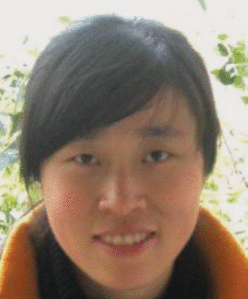 Tingting Zhang received her Bachelor's degree in Electronic Engineering and Master's degree in Optical Engineering from the Southeast University in China. Her research interests include perception of depth-of-field, stereoscopic depth perception, and so on. Currently, Tingting works as a PhD student at the Delft University of Technology.
Tingting Zhang received her Bachelor's degree in Electronic Engineering and Master's degree in Optical Engineering from the Southeast University in China. Her research interests include perception of depth-of-field, stereoscopic depth perception, and so on. Currently, Tingting works as a PhD student at the Delft University of Technology.
 Harold T. Nefs received his Master's degree in Experimental Psychology from Utrecht University and a PhD in physics of man. His research interests include visual “shape-from-shading” perception, stereoscopic depth perception, eye movements, motion-in-depth perception, and presence formation. Currently, Harold works as a post-doctoral researcher at the Delft University of Technology.
Harold T. Nefs received his Master's degree in Experimental Psychology from Utrecht University and a PhD in physics of man. His research interests include visual “shape-from-shading” perception, stereoscopic depth perception, eye movements, motion-in-depth perception, and presence formation. Currently, Harold works as a post-doctoral researcher at the Delft University of Technology.
 Paul B. Hibbard studied Psychology at University College London, where he gained a BSc and PhD. He then worked at the University of Surrey as a research fellow, and as a lecturer, then senior lecturer, at the University of St Andrews. He joined the department of Psychology at the University of Essex in 2013.
Paul B. Hibbard studied Psychology at University College London, where he gained a BSc and PhD. He then worked at the University of Surrey as a research fellow, and as a lecturer, then senior lecturer, at the University of St Andrews. He joined the department of Psychology at the University of Essex in 2013.
Contributor Information
Louise O'Hare, School of Psychology and Neuroscience, University of St Andrews, St Mary's Quad, South Street, St Andrews, Fife KY16 9JP, UK; e-mail: lo26@st-andrews.ac.uk; Currently at: School of Psychology, University of Lincoln, Brayford Pool, Lincon LN1 3TS, UK; e-mail: lohare@lincoln.ac.uk.
Tingting Zhang, Delft University of Technology, Faculty of Electrical Engineering, Mathematics, and Computer Science, Interactive Intelligence Group, Mekelweg 4, 2628 CD Delft, the Netherlands; e-mail: t.zhang@tudelft.nl.
Harold T. Nefs, Delft University of Technology, Faculty of Electrical Engineering, Mathematics, and Computer Science, Interactive Intelligence Group, Mekelweg 4, 2628 CD Delft, the Netherlands; e-mail: h.t.nefs@tudelft.nl
Paul B. Hibbard, School of Psychology and Neuroscience, University of St Andrews, St Mary's Quad, South Street, St Andrews, Fife KY16 9JP, UK; e-mail: pbh2@st-andrews.ac.uk Currently at: Department of Psychology, University of Essex, Wivenhoe Park, Colcester CO4 3SQ, UK; e-mail: phibbard@essex.ac.uk.
References
- Banks M. S., Akeley K., Hoffman D. M., Girshick A. R. Consequences of incorrect focus cues in stereo displays. Information Display. 2008;24(7):10–14. [PMC free article] [PubMed] [Google Scholar]
- Banks M. S., Read J. C. A., Allison R. S., Watt S. J. Stereoscopy and the human visual system. SMPTE Motion Imaging Journal. 2012;121(4):24–32. doi: 10.5594/j18173. [DOI] [PMC free article] [PubMed] [Google Scholar]
- Bradshaw M. F., Glennerster A., Rogers B. J. The effect of display size on disparity scaling from differential perspective and vergence cues. Vision Research. 1996;36(9):1255–1264. doi: 10.1016/0042-6989(95)00190-5. [DOI] [PubMed] [Google Scholar]
- Brainard D. H. The psychophysics toolbox. Spatial Vision. 1997;10(4):433–436. doi: 10.1163/156856897X00357. [DOI] [PubMed] [Google Scholar]
- Charman W. N. Spatial frequency and the dynamics of the accommodation response. Optica Acta: International Journal of Optics. 1979;26(2):217–228. doi: 10.1080/713819958. [DOI] [Google Scholar]
- Charman W. N., Tucker J. Dependence of accommodation response on the spatial frequency spectrum of the observed object. Vision Research. 1977;17(1):129–139. doi: 10.1016/0042-6989(77)90211-5. [DOI] [PubMed] [Google Scholar]
- Day M., Siedel D., Gray L. S., Strang N. C. The effect of modulating ocular depth of focus upon accommodation microfluctuations in myopic and emmetropic subjects. Vision Research. 2009;49(2):211–218. doi: 10.1016/j.visres.2008.10.010. [DOI] [PubMed] [Google Scholar]
- de Groot S. G., Gebhard J. W. Pupil size as determined by adapting luminance. Journal of the Optical Society of America. 1952;42(7):492–495. doi: 10.1364/JOSA.42.000492. [DOI] [PubMed] [Google Scholar]
- Enns J. T., MacDonald S. C. The role of clarity and blur in guiding visual attention in photographs. Journal of Experimental Psychology: Human Perception and Performance. 2012;39(2):568–578. doi: 10.1037/a0029877. [DOI] [PubMed] [Google Scholar]
- Faul F., Erdfelder E., Buchner A., Lang A. G. Statistical power analyses using G*Power 3.1: Tests for correlation and regression analyses. Behavior Research Methods. 2009;41(4):1149–1160. doi: 10.3758/BRM.41.4.1149. [DOI] [PubMed] [Google Scholar]
- Faul F., Erdfelder E., Lang A. G., Buchner A. G*Power 3: A flexible statistical power analysis program for the social, behavioral, and biomedical sciences. Behavior Research Methods. 2007;39(2):175–191. doi: 10.3758/BF03193146. [DOI] [PubMed] [Google Scholar]
- Fernandez D., Wilkins A. J. Uncomfortable images in art and nature. Perception. 2008;37(7):1098–1013. doi: 10.1068/p5814. [DOI] [PMC free article] [PubMed] [Google Scholar]
- Held R. T., Cooper E., Banks M. S. Blur and disparity are complementary cues to depth. Current Biology. 2012;22(5):426–431. doi: 10.1016/j.cub.2012.01.033. [DOI] [PMC free article] [PubMed] [Google Scholar]
- Held R. T., Cooper E., O'Brien J., Banks M. S. Using blur to affect perceived distance and size. ACM Transactions on Graphics. 2010;29(2):19. doi: 10.1145/1731047.1731057. [DOI] [PMC free article] [PubMed] [Google Scholar]
- Hillaire S., Lecuyer A., Cozot R., Casiez G. Depth-of-field blur effects for first-person navigation in virtual environments. IEEE Computer Graphics and Applications. 2008;28(6):47–55. doi: 10.1109/MCG.2008.113. [DOI] [PubMed] [Google Scholar]
- Hoffman D. M., Banks M. S. Focus information is used to interpret binocular images. Journal of Vision. 2010;10(5):1–17. doi: 10.1167/10.5.13. [DOI] [PMC free article] [PubMed] [Google Scholar]
- Hoffman D. M., Girshick A. R., Akeley K., Banks M. S. Vergence-accommodation conflicts hinder visual performance and cause visual fatigue. Journal of Vision. 2008;8(3):834–862. doi: 10.1167/8.3.33. [DOI] [PMC free article] [PubMed] [Google Scholar]
- Holliman N. S. Mapping perceived depth to regions of interest in stereoscopic images. Proceedings of SPIE. 2004;5291:117–128. doi: 10.1117/12.525853. [DOI] [Google Scholar]
- Jones G. R., Lee D., Holliman N. S., Ezra D. Controlling perceived depth in stereoscopic images. Proceedings of SPIE. 2001;4297:42–53. doi: 10.1117/12.430855. [DOI] [Google Scholar]
- Juricevic I., Land L., Wilkins A. J., Webster M. A. Visual discomfort and natural image statistics. Perception. 2010;39(7):884–899. doi: 10.1068/p6656. [DOI] [PMC free article] [PubMed] [Google Scholar]
- Kleiner M., Brainard D., Pelli D. What's new in psychtoolbox-3? 2007. Perception, 36 ECVP Abstract Supplement. [DOI]
- Murray S., Bex P. J. Perceived blur in naturally-contoured images depends on phase. Frontiers in Psychology. 2010;1(185):1–12. doi: 10.3389/fpsyg.2010.00185. [DOI] [PMC free article] [PubMed] [Google Scholar]
- Nefs H. T. Depth of field affects perceived depth-width ratios in photographs of natural scenes. Seeing and Perceiving. 2012;25(6):577–95. doi: 10.1163/18784763-00002400. [DOI] [PubMed] [Google Scholar]
- O'Hare L., Hibbard P. B. Spatial frequency and visual discomfort. Vision Research. 2011;51(15):1767–1777. doi: 10.1016/j.visres.2011.06.002. [DOI] [PubMed] [Google Scholar]
- O'Hare L., Hibbard P. B. Visual discomfort and blur. Journal of Vision. 2013;13(5):1–12. doi: 10.1167/13.5.7. [DOI] [PubMed] [Google Scholar]
- Pelli D. G. The VideoToolbox software for visual psychophysics: Transforming numbers into movies. Spatial Vision. 1997;10(4):437–442. doi: 10.1163/156856897x00366. [DOI] [PubMed] [Google Scholar]
- Percival A. S. The relation of convergence to accommodation and its practical bearing. Ophthalmological Review. 1892;11:313–328. [Google Scholar]
- Sheedy J. E., Hayes J. N., Engle J. Is all asthenopia the same? Optometry and Vision Science. 2003;80(11):732–739. doi: 10.1097/00006324-200311000-00008. [DOI] [PubMed] [Google Scholar]
- Shibata T., Kim J., Hoffman D. M., Banks M. S. Visual discomfort with stereo displays: Effects of viewing distance and direction of vergence–accommodation conflict. Proceedings of the SPIE: Stereoscopic Displays and Applications. 2011a;7863:1–9. doi: 10.1117/12.872347. [DOI] [PMC free article] [PubMed] [Google Scholar]
- Shibata T., Kim J., Hoffman D. M., Banks M. S. The zone of comfort: Predicting visual discomfort with stereo displays. Journal of Vision. 2011b;11(8):1–29. doi: 10.1167/11.8.11. [DOI] [PMC free article] [PubMed] [Google Scholar]
- Smallman H. S., MacLeod D. I. A. Spatial scale interactions in stereo sensitivity and the neural representation of binocular disparity. Perception. 1997;26(8):977–994. doi: 10.1068/p260977. [DOI] [PubMed] [Google Scholar]
- Thibos L. N., Himebaugh N. L., Coe C. D. Wavefront refraction. In: Benjamin W. J., editor. Borish's clinical refraction. 2nd Edition. Oxford: Butterworth-Heinemann; 2006. pp. 765–789. [Google Scholar]
- Tosha C., Borsting E., Ridder W. H., III, Chase C. Accommodation response and visual discomfort. Ophthalmic and Physiological Optics. 2009;29(6):625–633. doi: 10.1111/j.1475-1313.2009.00687.x. [DOI] [PubMed] [Google Scholar]
- Vishwanath D., Blaser E. Retinal blur and the perception of egocentric distance. Journal of Vision. 2010;10(10):1–16. doi: 10.1167/10.10.26. [DOI] [PubMed] [Google Scholar]
- Wang J., Barkowsky M., Ricordel V., LeCallet P. Quantifying how the combination of blur and disparity affects the perceived depth. Proceedings of the SPIE, International Society Opthalmology and Engineering. 2011;118(1–2):194–200. doi: 10.1117/12.876703. [DOI] [Google Scholar]
- Wann J. P., Rushton S., Mon-Williams M. Natural problems for stereoscopic depth perception in virtual environments. Vision Research. 1995;35(19):2731–2736. doi: 10.1016/0042-6989(95)00018-U. [DOI] [PubMed] [Google Scholar]
- Watt S. J., Akeley K., Ernst M. O., Banks M. S. Focus cues affect perceived depth. Journal of Vision. 2005;5(10):834–862. doi: 10.1167/5.10.7. [DOI] [PMC free article] [PubMed] [Google Scholar]
- Zhang T., Nefs H. T., Heynderickx I. Discrimination of depth of field in natural images. (in preparation)



